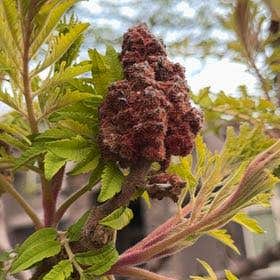





































Staghorn Sumac
About Staghorn Sumac
It is drought tolerant and grows up to 25' tall. It is native to woodland edges, roadsides, railroad embankments and stream/swamp margins from Quebec to Ontario to Minnesota south to Georgia, Indiana and Iowa. It's not poisonous but can be weedy, spreading by suckers to form colonies.
Taxonomy

Rhus typhina
Rhus
Anacardiaceae
Sapindales

How to care for Staghorn Sumac
How often to water your Staghorn Sumac

every 9
Staghorn Sumac needs 0.5 cups of water every 9 when it doesn’t get direct sunlight and is potted in a 5" pot.
Use our water calculator to personalize watering recommendations to your environment or download Greg for more advanced recommendations for all of your plants.

Water 0.5 cups every
9
Finding light for Staghorn Sumac in your home

a window
Staghorn Sumac love being close to bright, sunny windows 😎.
Place it less than 1ft from a south-facing window to maximize the potential for growth.
Staghorn Sumac does not tolerate low-light 🚫.
Select your region to see how the current weather in your area affects the placement of Staghorn Sumac in your home 🏡.
How to fertilize Staghorn Sumac

Most potting soils come with ample nutrients which plants use to produce new growth.
By the time your plant has depleted the nutrients in its soil it’s likely grown enough to need a larger pot anyway.
To replenish this plant's nutrients, repot your Staghorn Sumac after it doubles in size or once a year—whichever comes first.
Care Summary for Staghorn Sumac

Staghorn Sumac
 Greg recommends:
Greg recommends:
 Water
Water
0.5 cups every 9 days
 Placement
Placement
< 1ft from a window
 Nutrients
Nutrients
Repot after 2x growth
Based on the 4” pot your plant is in, and that it doesn’t get direct sunlight.

 Trending in your area
Trending in your area
 Similar to Staghorn Sumac
Similar to Staghorn Sumac
✨ Discover rare plants

Dinteranthus microspe…

Echeveria Esther

Croton Nervia

Fagraea ceilanica

Anthurium Fingers

Philodendron eximium

Treasure Flower

Betel

Hoya 'Millie'

Electric Blue Gecko

Scindapsus pictus 'Si…

Cereus peruvianus 'Pa…

Aglaonema 'Green Bowl'

Burro's Tail

Philodendron 'Silver …

Raphionacme flanaganii

Hoya bordenii


























